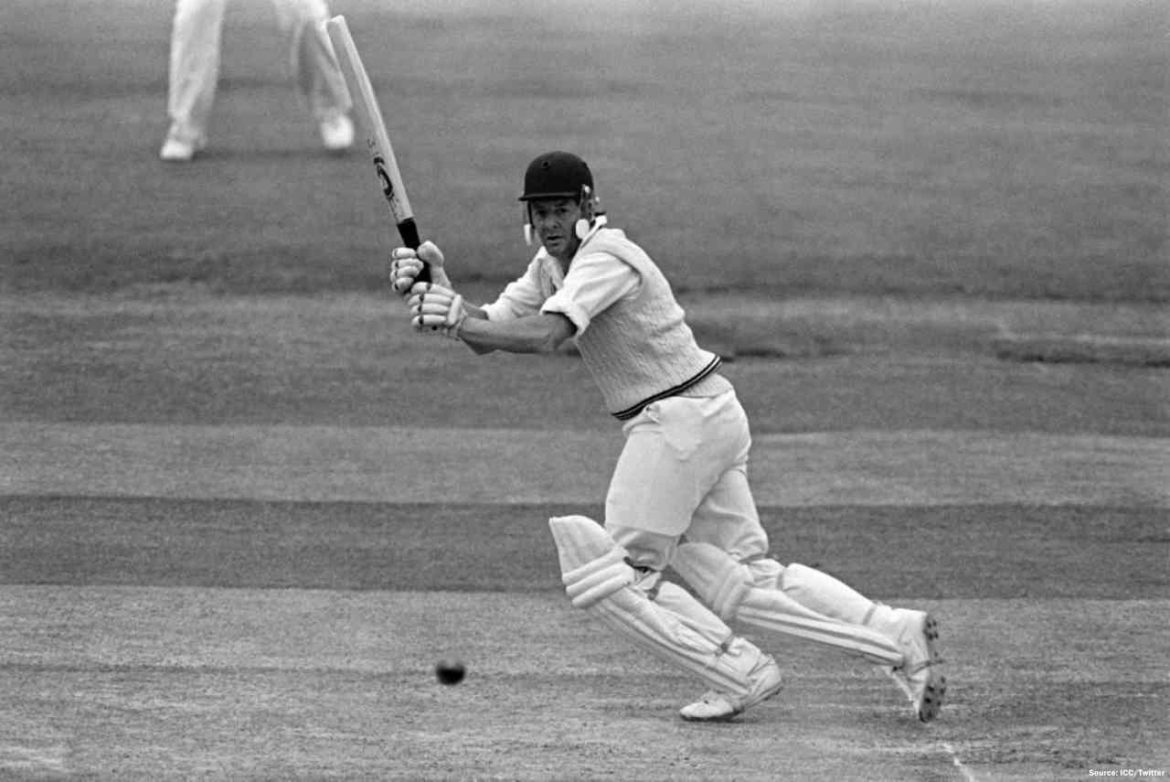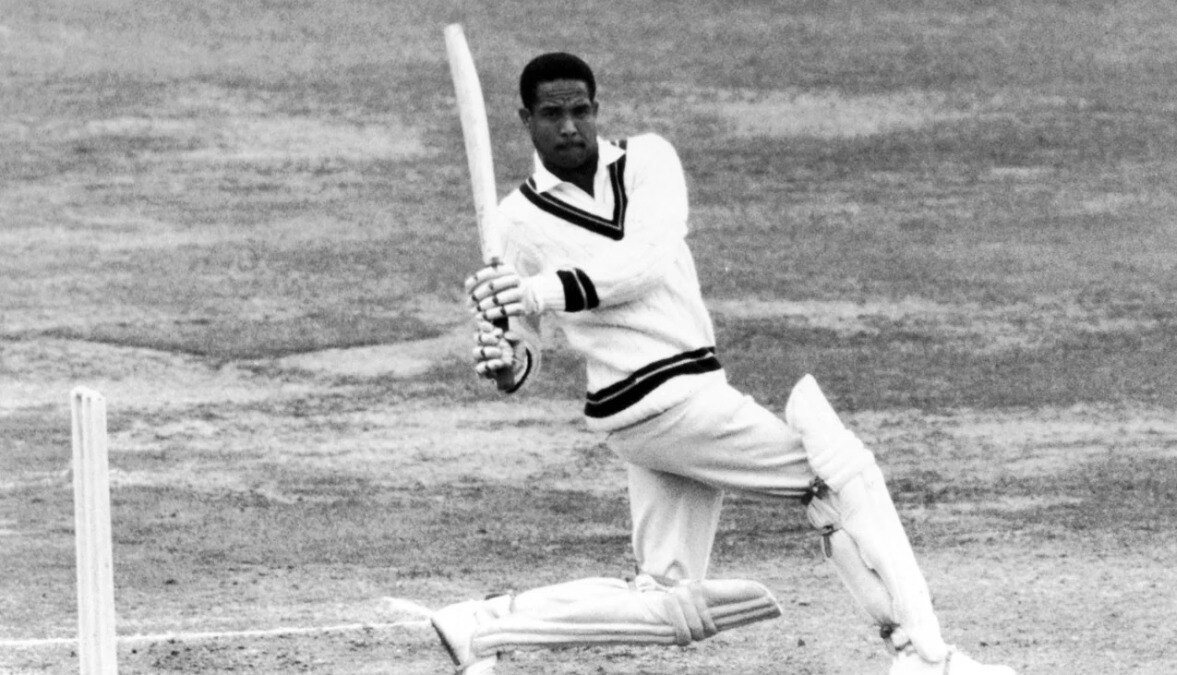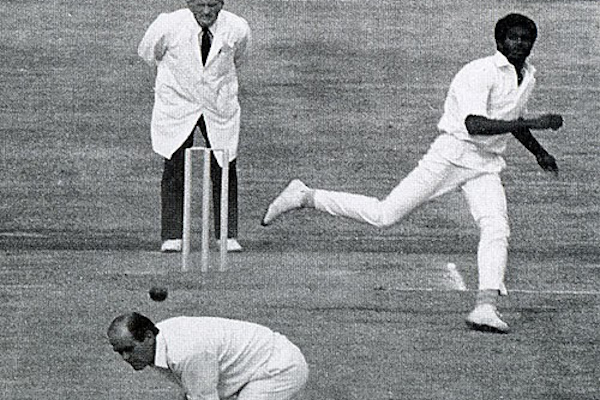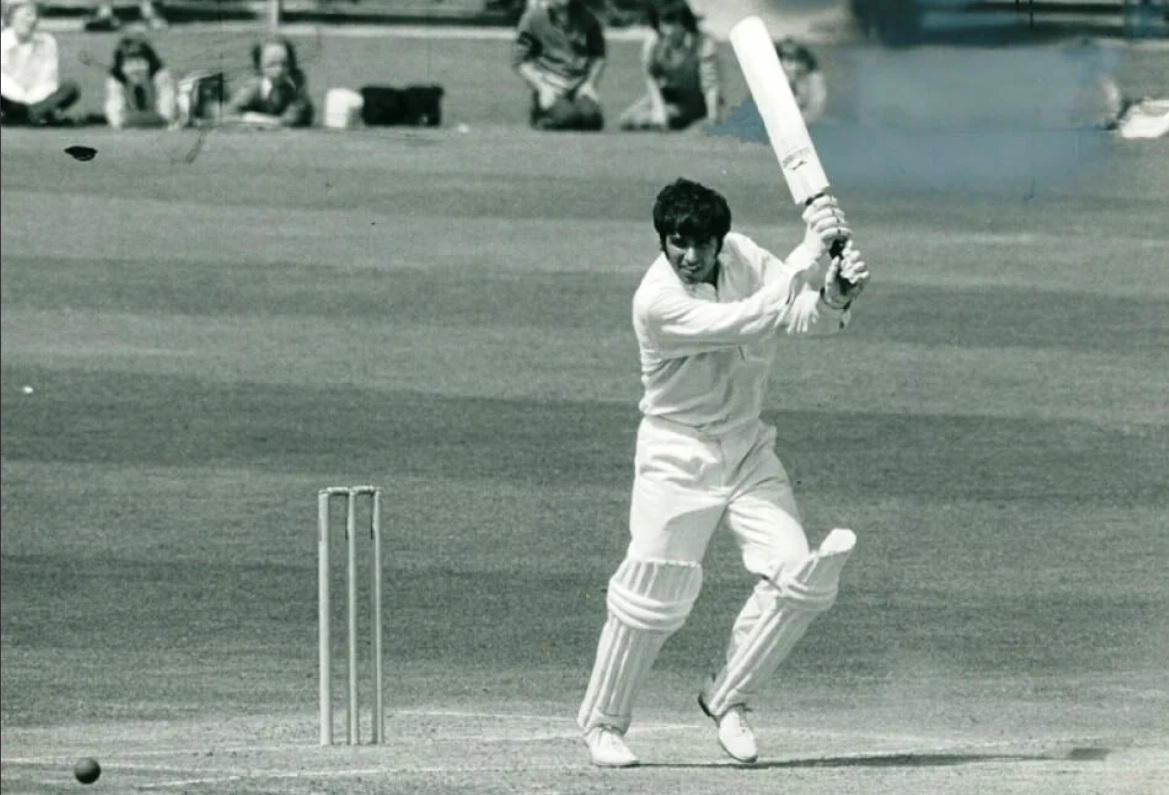“[…] I still remember watching Sir Everton Weekes during that third Test in Bourda, when he scored 81 out of a paltry West Indies total of 182.
“Wickets were falling continuously around him—[JK] Holt (12), [Jeffrey] Stollmeyer (16), [Clyde] Walcott (8), [Frank] Worrell (5), Garfield Sobers (12) and Denis Atkinson (13) all went cheaply.
“Weekes by contrast seemed to be ever so comfortable against the very strong Australia bowling attack of raw pace and good spin…”
Veteran sport reporter Joseph ‘Reds’ Perreira remembers late iconic West Indies cricketer Sir Everton Weekes—on and off the pitch:

(Copyright Skysports)
Like many West Indians, I was deeply saddened by the 1 July 2020 news of Sir Everton Weekes’ passing—even though, having known of his recent illnesses, it wasn’t at all unexpected.
Flooded by sadness as I was, my mind was immediately filled with my own personal memories of the great man, some of which I am now honoured to share.
I first saw Sir Everton in 1953 when he played for the West Indies against India in the Fourth Test at Bourda in my home city of Georgetown, British Guiana.
At the age of 15, it was in fact my very first Test match, which began noticeably unpleasantly for me. Our own Leslie Wight, whom I admired, was in the side and expected to open the West Indies batting with the captain Jeffrey Stollmeyer when the home side started its reply to India’s first innings total of 262.
To the shock and surprise of almost everyone in the large sell-out crowd, however, it was Bruce Pairaudeau, also playing in his first home Test, who came out with Stollmeyer to open the batting. Pairaudeau had earned his selection after he had scored a 115 on debut for the West Indies in the First Test, which had been played at the Queen’s Park Oval in Port-of-Spain, Trinidad.

At Bourda, Pairaudeau was soon bowled by Gulabrai Ramchand for two runs. Yet Wight was not sent in at number 3 either. And, in fact, didn’t appear until much later at number 6 in the batting order.
Stollmeyer also fell cheaply, lbw to Vinoo Mankad for 13. His dismissal brought Frank Worrell and Weekes together—to be seen for the very first time by a massive BG crowd, after their great batting in England during the 1950 Series.
At Bourda, Weekes played the Indian’s twin spin threat of Subhash Gupte’s leg-spin and Mankad’s left arm off-spin much the better of the two batting maestros. Weekes was using his feet to the spin while Worrell, playing mostly from the crease, had some trouble with Gupte but fought on to score 56, before he was eventually bowled by Mankad.
Weekes was then joined by Clyde Walcott and what a joy it was to behold the different approaches between those two—the delicate stroke play and footwork of Weekes, starkly contrasted by Walcott’s massive power.
Ramchand’s inswingers to Weekes were effortlessly flicked away off his pads to the backward square and midwicket boundaries. Weekes also drove Mankad delightfully through cover and extra cover, while using the most exquisite late cuts against Gupte’s leg breaks.

Walcott meanwhile was sheer power off the back foot, straight hitting several sixes out of the ground into Regent Street. The two added 130 for the fifth wicket before Weekes fell lbw to Ramchand for a stroke-filled 86. Walcott powered on to 125, falling lbw to Vijay Hazare, in a West Indies total of 364. The Test ended in an uneventful draw with each team having batted only once.
The India Squad for the 1952-53 Test Series was, to my view, one of the very best fielding sides to have ever visited the Caribbean. Chandrasekhar Gadkari was in particular absolutely outstanding in the covers and there were several other excellent fielders as well.
My next first-hand exposure to the greatness of Sir Everton’s batting occurred just a year later, during England’s 1954 Caribbean Tour. That tour had its fair share of grudges, particularly on the part of the Len Hutton-led English team, after Lord Kitchener famously celebrated West Indies’ first-ever Test win on English soil during the preceding series between the two adversaries.
West Indies started splendidly, getting off to a 2-nil series lead. They handily won the Sabina Park Jamaica first Test by a handsome margin of 140 runs.
Weekes led the West Indies batting overall with scores of 55 in the first innings and 90 not out in the second and there were other useful first strike contributions from Jamaica’s JK Holt (94), Walcott (65), Stollmeyer (60) and Guyana’s wicket-keeper batsman Clifford McWatt, who scored a belligerent 54 on his debut, as the West Indies compiled 417.

That proved a mountain too high for England who fell cheaply to the combined bowling efforts of Sonny Ramadhin (4), Alf Valentine (3) and Gerry Gomez (3) to be all out for 170.
Batting a second time the West Indies, on the back of Weekes’ unbeaten 90, reached 209-6 before declaring to leave England with an unlikely victory target of 456. They managed to get only 316 of those required runs, as Esmond Kentish claimed 5-49 to lead the West Indies to victory by 140 runs!
Weekes missed the second Test in his hometown Barbados as a result of an injury. Despite his absence, the West Indies again won handily by a margin of 181 runs. BG hosted the third Test Match, which England absolutely had to win in order to keep the series alive.
Thanks to a masterful knock of 169 by their captain Len Hutton, England’s got off to an impressive start as the tourists scored 435, having taken first strike.
In reply, the West Indies soon found themselves in trouble, losing early wickets to be struggling at 12-3—Worrell (0), Stollmeyer (2) and Walcott (4) all fell cheaply to Brian Statham’s swing.

(via ESPN)
Statham was proving to be a handful before Weekes came to the crease to take the attack back to England’s top seamer, with repeated front foot drives straight past the bowler down to the North fence boundary for fours.
Weekes found a useful partner in Robert Christiani, who, playing on his home ground, contributed 25 in a 52-run partnership for the fourth wicket.
At 94, playing forward to Tony Lock, Weekes was given out bowled—although the spectators seated in the Rails stand next to the scoreboard and just beyond Bourda’s very close square-leg boundary were certain that England’s wicket-keeper Godfrey Evans nudged off the bails.
Weekes’ controversial dismissal prevented him from reaching what seemed to be a certain century.
Local boy Cliff McWatt and JK Holt both showed great fight in adding 99 for the eighth wicket before McWatt was run out for 54 to end the West Indies’ resistance. The Guyanese crowd, already angered by Weekes dismissal, expressed their displeasure by throwing bottles onto the field, for the first time ever in Test cricket’s history.

(Copyright BBC)
Play did resume and West Indies were eventually dismissed for 251 with Holt left not out on 48. Asked to follow on, West Indies were dismissed for 256 in its second innings with Weekes scoring just 38.
Left with a target of only 72, England comfortably secured the required victory by 9 wickets. Weekes did not stop making runs in the series however, as in the fourth Test at Port-of-Spain, he scored 206 in the West Indies massive first innings total of 681.
A very strong, heavy scoring, Australia team easily won the 1955 Series in the West Indies 3-0. Neil Harvey was absolutely outstanding, scoring an aggregate of 650 runs during the series with an innings average of 105! He was very well supported by Colin MacDonald and Keith Miller who had series aggregates of 449 and 439 respectively.
For the Australians, Miller and Ray Lindwall each had 20 wicket series hauls while Ritchie Benaud was only marginally behind with 18 wickets.
Walcott was the West Indies’ stand out batsman, registering a mammoth series aggregate of 827 runs at a 82.70 average. Weekes was the next best, with 469 runs at an ave of 56.62.
I still remember watching Sir Everton during that third Test in Bourda, when he scored 81 out of a paltry West Indies total of 182.

(Copyright Getty)
Wickets were falling continuously around him—Holt (12), Stollmeyer (16), Walcott (8), Worrell (5), Garfield Sobers (12) and Denis Atkinson (13) all went cheaply. Weekes by contrast seemed to be ever so comfortable against the very strong Australia bowling attack of raw pace and good spin.
When he eventually fell, caught by Ron Archer off Benaud’s bowling for a well-played 81, the entire Bourda crowd stood and cheered him all the way back to the pavilion.
Like most great players, he had a very special walk which, although simple, exuded confidence from his 5 foot 8 inch frame.
It wasn’t until 1968 that I finally had the honour of meeting Everton Weekes in person. That was in Trinidad during the 1968 West Indies-England Test series, for which Weekes had been appointed as the West Indies Team Manager.
I was sitting with Clive Lloyd and Steve Camacho at the Normandie Hotel restaurant and as he came up to our table, Clive introduced us formally to each other. When Weekes found out that I had in fact come to Trinidad specifically for the Test, he offered me tickets for the entire match, as well as a ride to the Oval each and every morning.

(via Skynews)
My next opportunity to know him further was during the second Test of the West Indies-Australia 1973 series in Barbados. I was invited to the President’s Box for lunch on days two and five of the Test and spent much of the time there delightfully chatting cricket with the great man.
I also lived in Barbados for almost five years, from 1980 onwards. During that period, myself and Tony Cozier did CBC radio commentaries with the great man for over two years. I was able to invite him to my humble Rockley flat and he in turn had me over several times for lunch and dinner at his Atlantic Shores home on the beach.
When I eventually moved to St Lucia to head the newly created OECS Sports Desk, I stayed in touch with him by phone during his later days and in person on my fairly frequent visits to Barbados.
Precious memories of actually seeing him bat and of our personal interactions will be forever fondly cherished. Rest In Peace Sir Everton. Thanks for the memories.

(via Buzz Caribbean)
Want to share your thoughts with Wired868? Email us at editor@wired868.com.
Please keep your letter between 300 to 600 words and be sure to read it over first for typos and punctuation.
We don’t publish anonymously unless there is a good reason, such as an obvious threat of harassment or job loss.
 Wired868 Wired868 for smart sport news and opinion
Wired868 Wired868 for smart sport news and opinion






